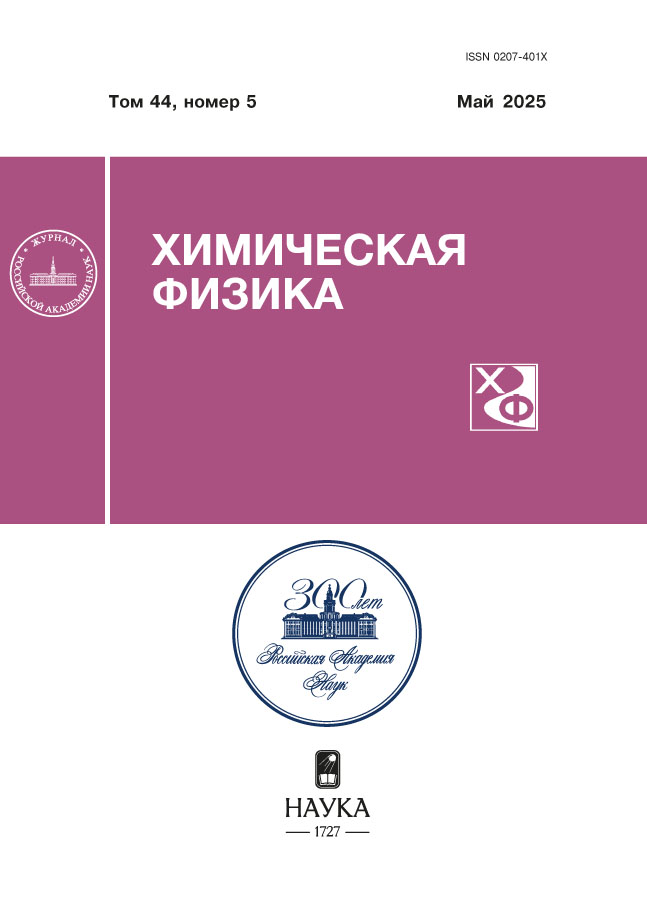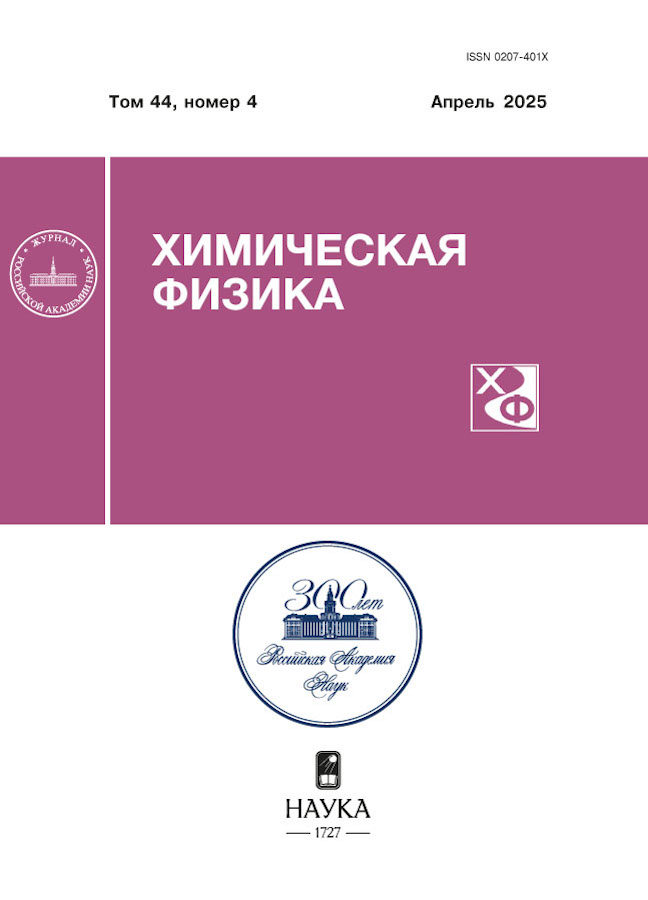Catalytical ignition of deuterium – carbon monoxide – air mixtures over metallic rhodium surface at pressures of 1–2 atm
- Authors: Troshin K.Y.1, Rubtsov N.M.2,3, Chernysh V.I.2, Tsvetkov G.I.2, Shamshin I.O.1, Izmaylova Y.A.4, Kalinin A.P.5, Leontiev A.A.4, Rodionov A.I.1,4
-
Affiliations:
- Semenov Federal Research Center for Chemical Physics, Russian Academy of Sciences
- Merzhanov Institute of Structural Macrokinetics and Materials Science
- Joint Institute for High Temperatures of the Russian Academy of Sciences
- “Reagent” Research and &Developmet Center, Joint-Stock company
- Ishlinsky Institute for Problems of Mechanics, Russian Academy of Sciences
- Issue: Vol 44, No 4 (2025)
- Pages: 88-96
- Section: Combustion, explosion and shock waves
- URL: https://ta-journal.ru/0207-401X/article/view/682730
- DOI: https://doi.org/10.31857/S0207401X25040109
- ID: 682730
Cite item
Abstract
It is established that the temperature dependences of the lower limit of catalytic ignition of stoichiometric mixtures D2 + CO + air and H2 + CO + air over the surface of metallic rhodium at pressures above 1 atm are close to each other. The fact that the temperature dependences of the upper limit of the catalytic ignition of deuterium and hydrogen in a mixture with CO differ markedly, and these of the lower limit are very close, may be due to the different adsorption capacity of carbon monoxide poisoning the untreated surface of the noble metal hydride/deuteride on the upper limit. At the same time, at the lower limit of catalytic ignition, the surface layer of adsorbed carbon monoxide is restored with each subsequent admission of the combustible mixture, containing CO. It is shown that the primary source of ignition of a mixture of D2 + CO + air occurs on the rhodium surface; in subsequent experiments, at a pressure above 1 atm, under the same conditions, the place of origin of the initial source changes. It has been found that the periods of delay of catalytic ignition only increase with decreasing temperature, which is associated with the adsorption of carbon monoxide poisoning the catalyst on the surface of the noble metal hydride/deuteride at the upper catalytic limit, while the state of the surface of the noble metal changes only due to the burning-out of CO layer at the first ignition. However, the surface layer of the adsorbed carbon monoxide is restored with each subsequent injection of the combustible mixture containing CO when approaching the lower catalytic limit. Analysis of the visible and infrared spectra of the catalytic ignition of D2-CO-air mixtures allowed us to establish that the heating in the D2 - CO–air flame is significantly higher than during the combustion of deuterium in air, and also to identify emission bands of heavy water in the combustion products.
Full Text
About the authors
K. Ya. Troshin
Semenov Federal Research Center for Chemical Physics, Russian Academy of Sciences
Email: nmrubtss@mail.ru
Russian Federation, Moscow
N. M. Rubtsov
Merzhanov Institute of Structural Macrokinetics and Materials Science; Joint Institute for High Temperatures of the Russian Academy of Sciences
Author for correspondence.
Email: nmrubtss@mail.ru
Russian Federation, Chernogolovka; Moscow
V. I. Chernysh
Merzhanov Institute of Structural Macrokinetics and Materials Science
Email: nmrubtss@mail.ru
Russian Federation, Chernogolovka
G. I. Tsvetkov
Merzhanov Institute of Structural Macrokinetics and Materials Science
Email: nmrubtss@mail.ru
Russian Federation, Chernogolovka
I. O. Shamshin
Semenov Federal Research Center for Chemical Physics, Russian Academy of Sciences
Email: nmrubtss@mail.ru
Russian Federation, Moscow
Yu. A. Izmaylova
“Reagent” Research and &Developmet Center, Joint-Stock company
Email: nmrubtss@mail.ru
Russian Federation, Moscow
A. P. Kalinin
Ishlinsky Institute for Problems of Mechanics, Russian Academy of Sciences
Email: nmrubtss@mail.ru
Russian Federation, Moscow
A. A. Leontiev
“Reagent” Research and &Developmet Center, Joint-Stock company
Email: nmrubtss@mail.ru
Russian Federation, Moscow
A. I. Rodionov
Semenov Federal Research Center for Chemical Physics, Russian Academy of Sciences; “Reagent” Research and &Developmet Center, Joint-Stock company
Email: nmrubtss@mail.ru
Russian Federation, Moscow; Moscow
References
- N.M. Rubtsov, K.Ya. Troshin, M.I. Alymov. Catalytic ignition of hydrogen and hydrogen-hydrocarbon blends over noble metals, Springer International Publishing. 2023, ISSN 978-3-031-28415-1
- F. Zhaolei Zheng, Z.Zhu. ACS Omega 7, 26375 (2022).
- N. Kousheshi, M. Y. Paykani. Energies 13, 212 (2020).
- N.R. Walker, F.D.F. Chuahy, R.D. Reitz. In Proceedings of the ASME 2015 Internal Combustion Engine Division Fall Technical Conference, Houston, TX, USA, 8–11 November 2015.
- M. Wissink, R.D. Reitz. SAE Int. J. Engines 8, 878 (2015).
- C. Appel, J. Mantzaras, R.Schaeren R. Bombach, A. Inauen. Clean Air. 5, 21 (2004). https://doi.org/10.1615/InterJEnerCleanEnv.v5.N1.20
- R. Wires, L.A. Watermeier, R.A. Strehlow. J. Phys. Chem. 63, 989 (1959).
- A.E. Shilov, G.B. Shul’pin, Activation and catalytic reactions of saturated hydrocarbons in the presence of metal complexes, Springer Science & Business Media (2001).
- N.M. Rubtsov, V.I. Chernysh, G.I. Tsvetkov, K.Ya. Troshin. Combust. Flame 218, 179 (2020).
- K.Ya. Troshin, N.M. Rubtsov, G.I. Tsvetkov, V.I. Chernysh, I.O. Shamshin. Russ. J. Phys. Chem. B 17 (2), 433 (2023). https://doi.org/10.1134/S1990793123020185
- I.D. Rodionov, A.I. Rodionov, L.A. Vedeshin, V.V. Egorov, A.P. Kalinin. Izv. Atmosph. Ocean. Phys. 50 (9), 989 (2014). https://doi.org/10.1134/S0001433814090175
- K.Ya. Troshin, N.M. Rubtsov, G.I. Tsvetkov, V.I. Chernys. Russ. J. Phys. Chem. B 16 (1), 39 (2022). https://doi.org/10.1134/S199079312201016X
- K.Ya. Troshin, N.M. Rubtsov, G.I. Tsvetkov, V.I. Chernysh, I.O Shamshin. Russ. J. Phys. Chem. B 16 (4), 693 (2022). https://doi.org/10.1134/S1990793122040303
- K.Ya. Troshin, N.M. Rubtsov, G.I. Tsvetkov, V.I. Chernysh, I.O. Shamshin. Russ. J. Phys. Chem. B 17 (4), 979 (2023). https://doi.org/10.1134/S1990793123040310
- Thermodynamic Calculations / version1.0 alpha / N.N. Semenov Institute of Chemical Physics and MIPHI.
- B. Lewis. Von Elbe G. Combustion, Explosions and Flame in Gases (Acad. Press, New York–London, 1987).
- S.Ya. Umansky, S.O. Adamson, A.S. Vetchinkin et al. J. Phys. Chem. B 17 (2), 346 (2023). https://doi.org/10.1134/S199079312302032X
- A.P. Kreshkov. [The grounds of analytical chemistry. Theoretical Grounds. Qualitative Analysis], 1970, Moscow, Ed. “Chemistry”, V. 3 [in Russian].
- M. Wang, H.An, W. Cai, X. Shao. Chemosensors 11, 37 (2023). https://doi.org/10.3390/chemosensors11010037
Supplementary files















